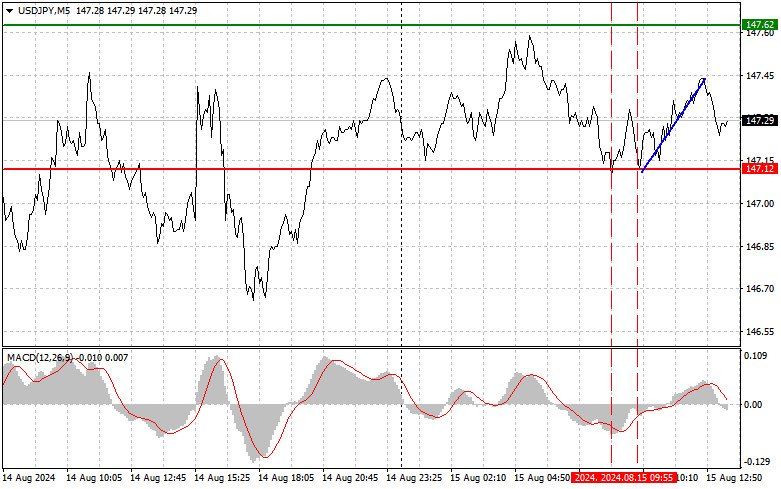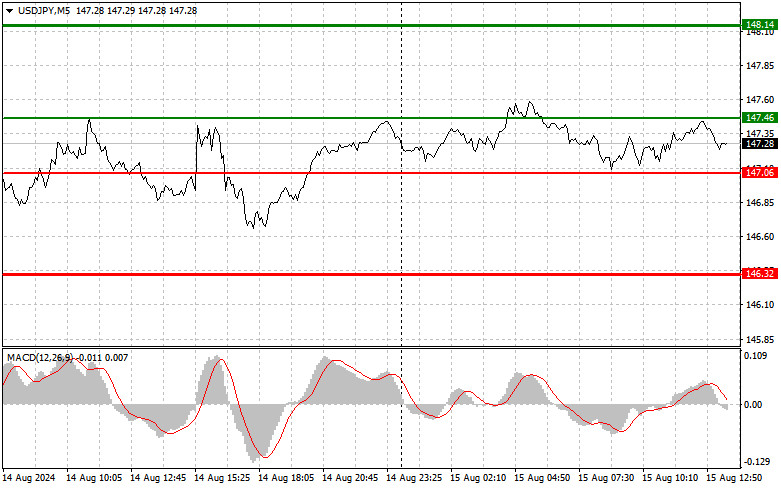
Analysis of Trades and Tips for Trading the Japanese Yen
The test of the 147.12 price level occurred when the MACD indicator moved significantly below the zero line and remained in the oversold area for a considerable period. This was sufficient to buy the dollar, anticipating its recovery. The second test of 147.12 confirmed the correct entry point into the market, resulting in a rise of more than 30 points. As you can see, the pair did not break out of the channel, largely due to the anticipated important statistics on the U.S. economy. The market may be influenced by the report on U.S. retail sales, as well as the speech by FOMC member Patrick T. Harker, who is known for his dovish stance, which could pose additional challenges for the dollar if the fundamental statistics disappoint. For the intraday strategy, I plan to act based on the implementation of scenarios No. 1 and No. 2.

Buy Signal
Scenario No. 1: Today, I plan to buy USD/JPY when the price reaches around 147.46 (green line on the chart) with a target of rising to 148.14 (thicker green line on the chart). Around 148.14, I will close my long positions and open short positions in the opposite direction (expecting a move of 30-35 points back down from the level). A strong rise in the pair today can be expected after positive news from the U.S. Note: Before buying, ensure that the MACD indicator is above the zero line and is just starting to rise.
Scenario No. 2: I also plan to buy USD/JPY today if there are two consecutive tests of the 147.06 price level when the MACD indicator is in the oversold area. This will limit the pair's downward potential and lead to an upward reversal. A rise to the resistance levels of 147.46 and 148.14 can be expected.
Sell Signal
Scenario No. 1: Today, I plan to sell USD/JPY after the 147.06 level (red line on the chart) is updated, which will lead to a quick decline in the pair. The key target for sellers will be the 146.32 level, where I will close my short positions and immediately open long positions in the opposite direction (expecting a move of 20-25 points back up from the level). Pressure on the pair will return if the statistics are weak. Note: Before selling, ensure that the MACD indicator is below the zero line and is just starting to decline.
Scenario No. 2: I also plan to sell USD/JPY today in case of two consecutive tests of the 147.46 price level when the MACD indicator is in the overbought area. This will limit the pair's upward potential and lead to a downward reversal. A decline to the support levels of 147.06 and 146.32 can be expected.

Chart Explanation:
Thin green line: The entry price at which the trading instrument can be bought.Thick green line: The projected price where you can set Take Profit or manually lock in profits, as further growth above this level is unlikely.Thin red line: The entry price at which the trading instrument can be sold.Thick red line: The projected price where you can set Take Profit or manually lock in profits, as further decline below this level is unlikely.MACD Indicator: When entering the market, it is important to use overbought and oversold zones.Important: Beginner traders in the Forex market should be very cautious when making market entry decisions. Before important fundamental reports are released, it's best to stay out of the market to avoid sudden price swings. If you decide to trade during news releases, always set stop-loss orders to minimize losses. Without stop-loss orders, you can quickly lose your entire deposit, especially if you don't use money management and trade in large volumes.
Remember, to trade successfully, you need a clear trading plan, like the one I presented above. Spontaneous trading decisions based on the current market situation are generally a losing strategy for an intraday trader.